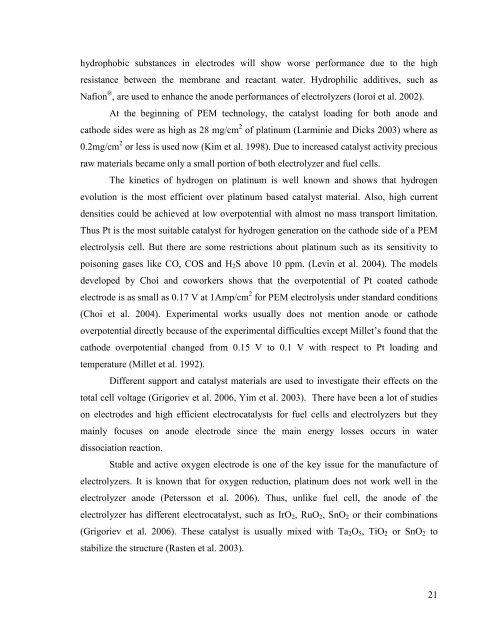hydrogen production from water using solar cells powered nafion ...
hydrogen production from water using solar cells powered nafion ...
hydrogen production from water using solar cells powered nafion ...
Create successful ePaper yourself
Turn your PDF publications into a flip-book with our unique Google optimized e-Paper software.
hydrophobic substances in electrodes will show worse performance due to the high<br />
resistance between the membrane and reactant <strong>water</strong>. Hydrophilic additives, such as<br />
Nafion ® , are used to enhance the anode performances of electrolyzers (Ioroi et al. 2002).<br />
At the beginning of PEM technology, the catalyst loading for both anode and<br />
cathode sides were as high as 28 mg/cm 2 of platinum (Larminie and Dicks 2003) where as<br />
0.2mg/cm 2 or less is used now (Kim et al. 1998). Due to increased catalyst activity precious<br />
raw materials became only a small portion of both electrolyzer and fuel <strong>cells</strong>.<br />
The kinetics of <strong>hydrogen</strong> on platinum is well known and shows that <strong>hydrogen</strong><br />
evolution is the most efficient over platinum based catalyst material. Also, high current<br />
densities could be achieved at low overpotential with almost no mass transport limitation.<br />
Thus Pt is the most suitable catalyst for <strong>hydrogen</strong> generation on the cathode side of a PEM<br />
electrolysis cell. But there are some restrictions about platinum such as its sensitivity to<br />
poisoning gases like CO, COS and H2S above 10 ppm. (Levin et al. 2004). The models<br />
developed by Choi and coworkers shows that the overpotential of Pt coated cathode<br />
electrode is as small as 0.17 V at 1Amp/cm 2 for PEM electrolysis under standard conditions<br />
(Choi et al. 2004). Experimental works usually does not mention anode or cathode<br />
overpotential directly because of the experimental difficulties except Millet’s found that the<br />
cathode overpotential changed <strong>from</strong> 0.15 V to 0.1 V with respect to Pt loading and<br />
temperature (Millet et al. 1992).<br />
Different support and catalyst materials are used to investigate their effects on the<br />
total cell voltage (Grigoriev et al. 2006, Yim et al. 2003). There have been a lot of studies<br />
on electrodes and high efficient electrocatalysts for fuel <strong>cells</strong> and electrolyzers but they<br />
mainly focuses on anode electrode since the main energy losses occurs in <strong>water</strong><br />
dissociation reaction.<br />
Stable and active oxygen electrode is one of the key issue for the manufacture of<br />
electrolyzers. It is known that for oxygen reduction, platinum does not work well in the<br />
electrolyzer anode (Petersson et al. 2006). Thus, unlike fuel cell, the anode of the<br />
electrolyzer has different electrocatalyst, such as IrO2, RuO2, SnO2 or their combinations<br />
(Grigoriev et al. 2006). These catalyst is usually mixed with Ta2O5, TiO2 or SnO2 to<br />
stabilize the structure (Rasten et al. 2003).<br />
21

















